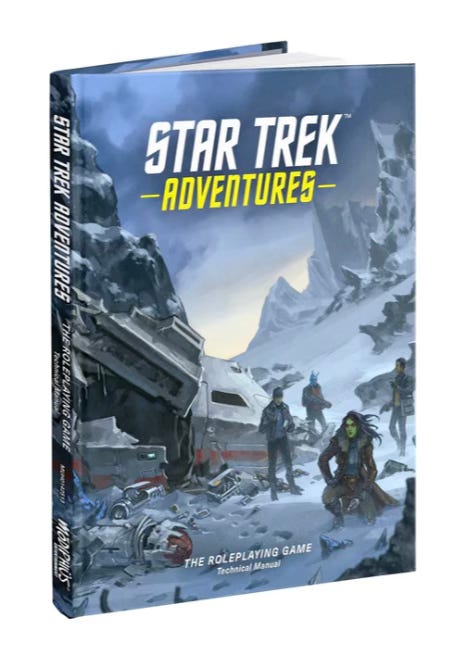Review: Technical Manual for Star Trek Adventures
A lot of fluff with some really useful bits for your STA game.
Modiphius had dropped its first supplement for the second edition of Stark Trek Adventures — the Technical Manual is a 129 pages of material on the various gear of the Star Trek universe. From the universal translator to tricorders, alien weapons to phasers, starship systems like the warp drive to replicators, the book gives some insight into the history and working of the toys of Trek.
There’s new career events choices for character building in the first chapter, as well as some nice talents for characters and service histories for starships that lean into the technical and the weird of the universe. There’s also a new section on space “mines” and the various different types. For those Discovery-philes, there’s material on the spore drive, and the quantum slipstream, transwarp, and protostar systems from the more recent shows also are featured.
Chapter 2 covers the usual equipment that the characters will encounter — from personal gear to replicators and holography. One of the better things that turns up in the chapters, and probably one of the best reasons to buy the book, is the charts for gear compications. Complications are one of the more important, and from what I’ve experienced, one the worst understood, game mechanics in the 2d20 system.
Chapter 3 is an odd choice that hasn’t, to my mind, ever features in a Trek RPG — diplomatic equipment, doctrine, and the like. There’s a large chunk of verbiage on the universal translator, and quite a few charts on complications for diplomatic missions and the use of the universal translator. Chapter 4 goes into scientific equipment, but also has some nice encounter and complication ideas for away teams. Chapter 5, similarly, medical equipment. The material here is influenced heavily by Strange New Worlds and Discovery — and real life: there’s cybernetics, genetic augmentations, and it even has PIke’s chair mentioned. 1966 Trek and the medicine of The Next Generation was advanced…except for places that should obviously been more so — Worf’s spinal injury, for instance. They could wire LaForge for sight, but not get around a spinal injury with cybernetics?
Chapter 6 deals with the transporter, heavily, and as it is one of the main McGuffins for all the series…good. There’s a section on computer technology from Enterprise to Picard, and a section on the engineering gear of the various eras, plus the complications charts and suggestions. Chapter 7 deals with weapons and armor: from the various hand-to-hand instruments of the various alien races to the various energy weapons, each with a little crypto-history lesson.
Chapter 8 rounds it out with starship systems, and here I think the complications tables for the various different things — from shield or engines, to artificial gravity — will be a big help in starship combat missions.
The layout is clean and in the same design as the 2nd Edition rulebook. This is a good thing, as the LCARS look of the 1st edition, while evocative of the TNG/DS9/VOY era, was a pain to read for most folks. This is clean, neat, easy to read. The artwork is suitably improved, as well. The artwork for the Trek line has always been on the good side, but they’ve been getting it right for the last series of sourcebooks and 2E. While right now, it’s only available on PDF, the pre-order for the physical book is available on the Modiphius website. I suspect they’ll drop it for GenCon, but if it’s the usual hardcover (and seems to be), their track record on physical quality is pretty good.
So is it worth it? At $50 buck on the website for a 129 page book, that’s a bit steep, in my opinion. Hell, the core book isn’t much more expensive for twice the page count and the 2E starter set is selling for $35 on the website. My suspicion is, once we get past GenCon and the release of the book, you’ll be able to find it for a more reasonable $25-30 online. Is it worth buying, yes; at $50…you be the judge.
The copyright for 2d20 system is Modiphius, 2019. STAR TREK and related marks and logos are trademarks of CBS Studios inc. All Rights Reserved and no infringement is intended.




